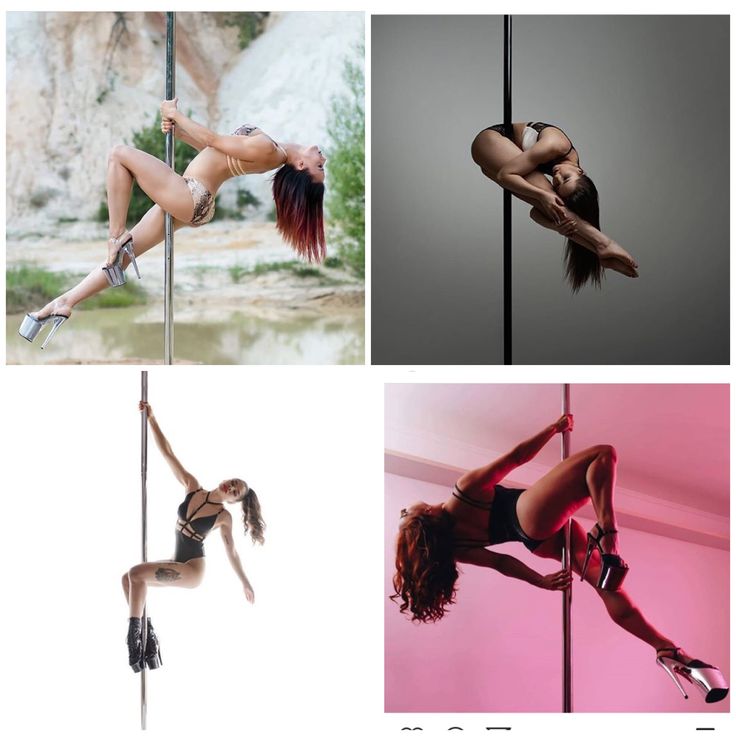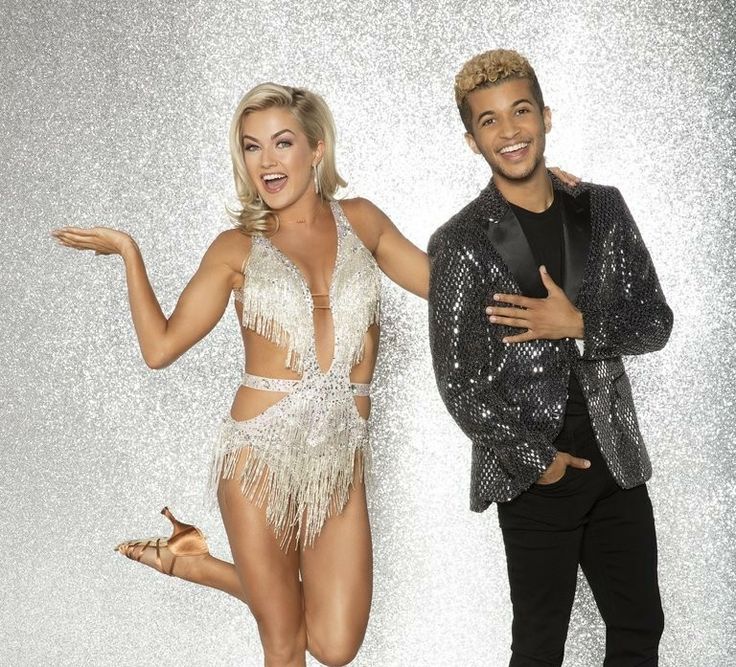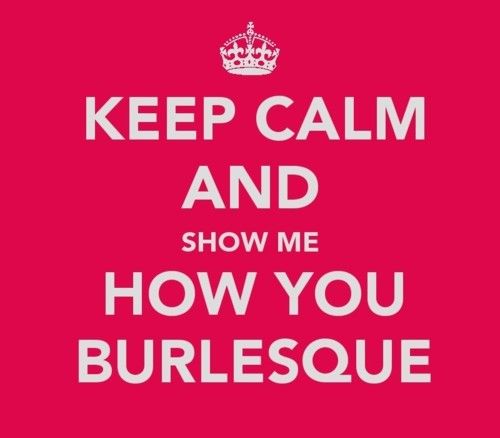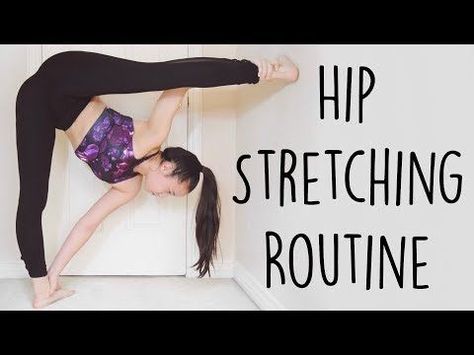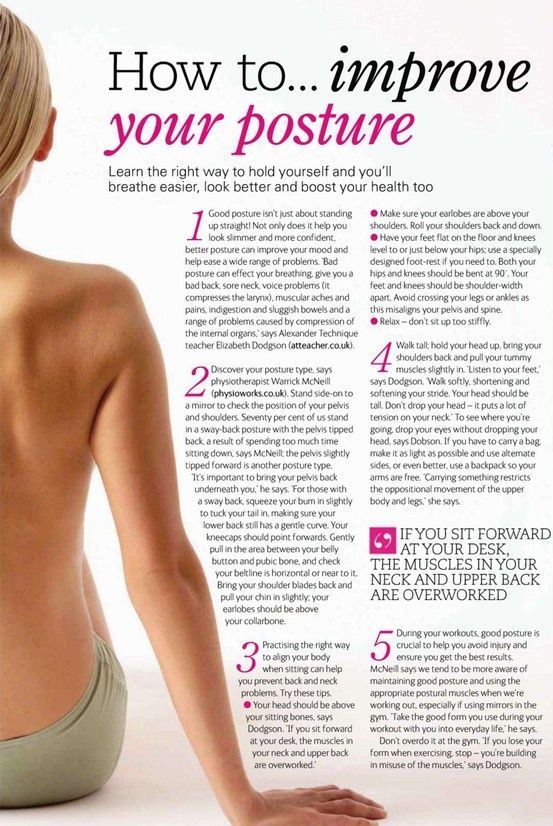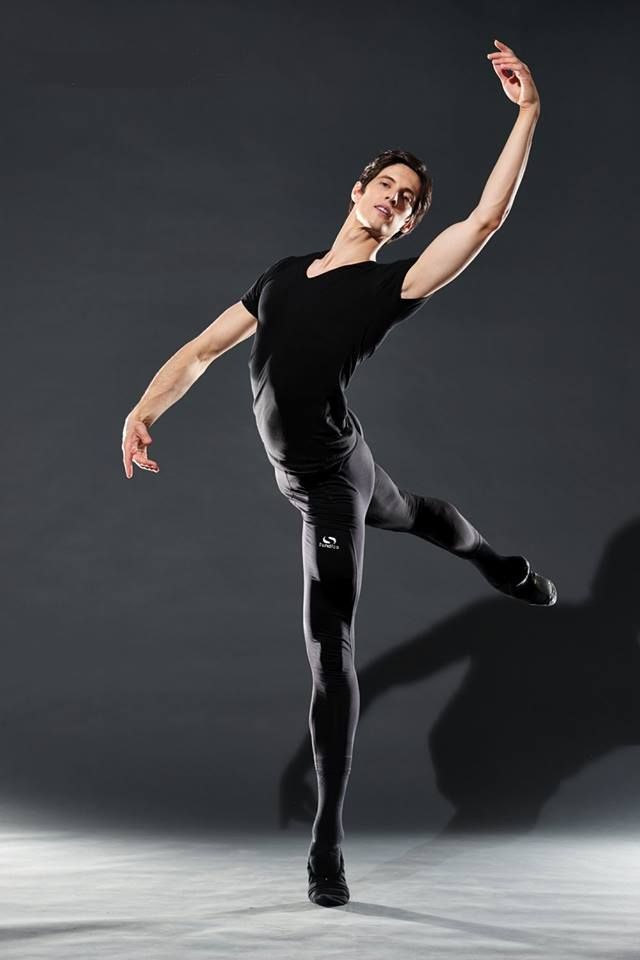How to pole dance tricks
A-Z Of Pole Dance Moves For Beginners
Whenever the word “pole dancing” is heard, people’s minds would immediately go off to the image of exotic nightclub dancers sensually circling a metal pole. While that’s undeniably the chief appeal of pole dancing, there’s more to pole dance moves than just eroticism and sexiness.
Pole dancing can be a legitimate sport and a form of art, too.
Nevertheless, no matter what your end-point is when you set out to learn, you’ve come to the right place if you’re looking for the basics of this dance. Here, you’ll find a list of all popular moves for beginners.
Contents
- 25 Popular Pole Dance Moves for Beginners
- 1. Front Hook Spin
- 2. Back Hook Spin
- 3. Chair Spin
- 4. Cradle Spin
- 5. Dip Spin
- 6. Fireman Spin
- 7. Wide Fireman Spin
- 8. Knee Spin
- 9. Secretary Spin
- 10. Steparound Spin
- 11. Basic Backbend (Pole Assisted)
- 12. Basic Body Rolls
- 13.
Basic Leg Waves
- 14. Basic Pole Climb
- 15. Cleopatra
- 16. Drama Queen
- 17. Fan Kick
- 18. High Kick Hold
- 19. Hip Dips
- 20. Pirouette
- 21. Pole Sit
- 22. Secretary Sit
- 23. Shoulder Stand
- 24. Sunwheel
- 25. Reverse Sunwheel
- Tips When Pole Dancing
- Take Care Of The Pole
- Do Not Use Skin Lotion
- Wear Shorts and Tank Top When You Practice
- Dance Barefoot Whenever Possible
- Practice!
- Be Brave
- Don’t Forget to Have Fun
- Final Words
25 Popular Pole Dance Moves for Beginners
1. Front Hook Spin
The Front Hook Spin (also known by other names like Showgirl Spin or Front Spin) is one of the simplest and easiest spin-type moves that you can learn.
In it, you simply wrap one of your legs around the pole, grip the pole with both of your arms, then spin around the pole. Your outer foot would be lifted off the ground, as well.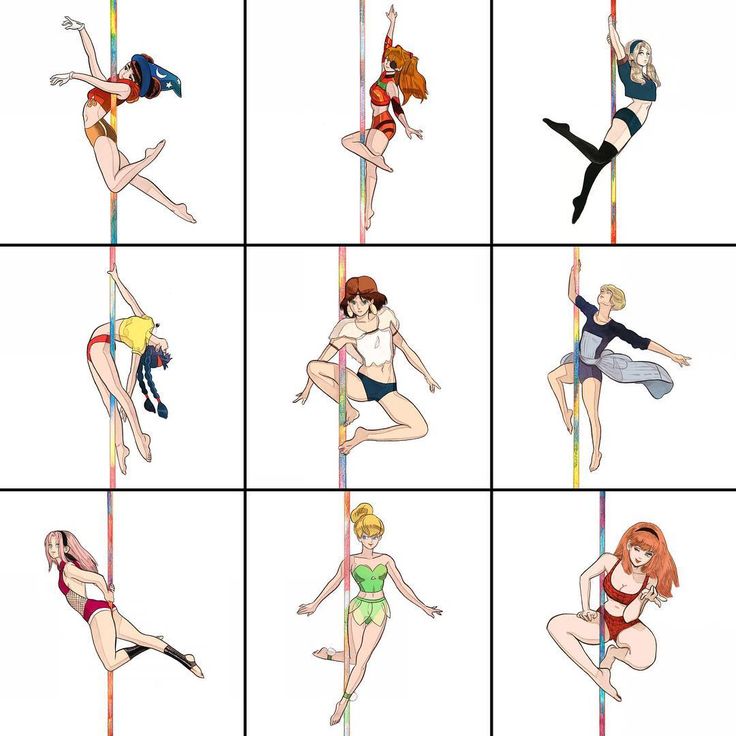
This is a great beginner pole dance position to try before you move on to more advanced techniques. With it, you can get used to the feeling of being off the floor. You will also be able to train your muscles and be more comfortable with lifting your body weight, as well.
Additional benefits of learning this dance move include its versatility. The hand placement of the Front Hook Spin means you can seamlessly transition to other moves and techniques. And last but not least, since your hands already provide all of the contacts needed to execute the spin, you can practice while wearing pants.
2. Back Hook Spin
The Back Hook Spin is exactly like the Front Hook Spin but reversed.
Don’t underestimate this dance move, however. Because of the difference in direction, it is mechanically different from the Front Hook Spin.
It also feels different, too. Because you can’t look behind your back, it can be a bit disorienting for beginners to learn.
3. Chair Spin
The Chair Spin (also known as the Seated Spin or the Sit Spin) is one of the more graceful beginner dance moves that you can learn.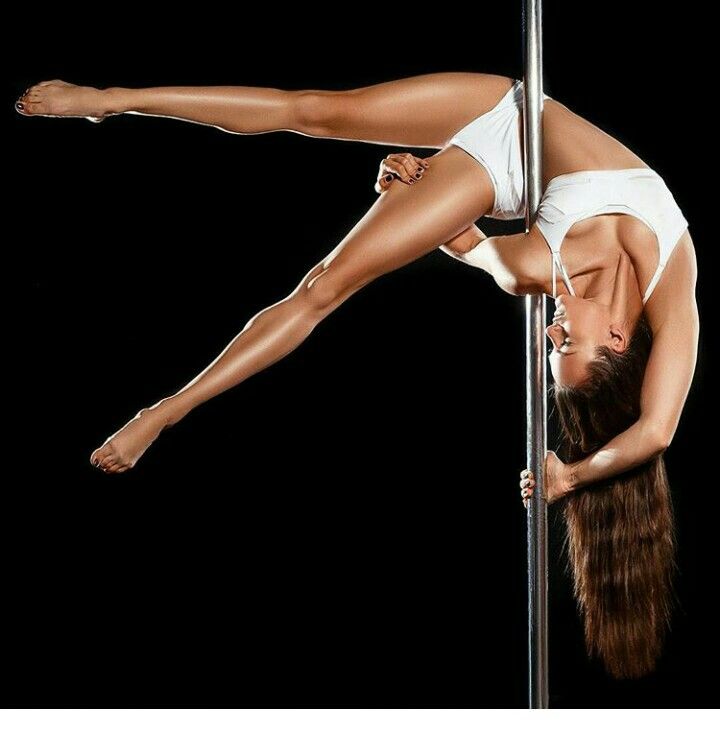 In it, you grip both arms around the pole and spin around it with your feet off of the ground. It should look as if you’re sitting on an invisible, revolving chair.
In it, you grip both arms around the pole and spin around it with your feet off of the ground. It should look as if you’re sitting on an invisible, revolving chair.
This dance move is excellent for beginners to learn about momentum, from how it works to how to control it.
4. Cradle Spin
In the Cradle Spin, you grip the pole with both arms and execute a maneuver that brings your body up and vertically, to finally wrap around the pole.
For most beginners, the Cradle Spin will likely be the first move you learn that involves the upper thighs. It’s also likely to be the first move that involves more than 2 or 3 points of contact (this one has 5). It’ll be able to break the monotony of the beginner’s routine.
Note that when you do this move, you should extend the pointer finger of your bottom hand. It’ll be more comfortable and you’ll be able to minimize the risks of getting a wrist injury.
Additionally, the Cradle Spin demands that you’re fluent with the Push Pull method.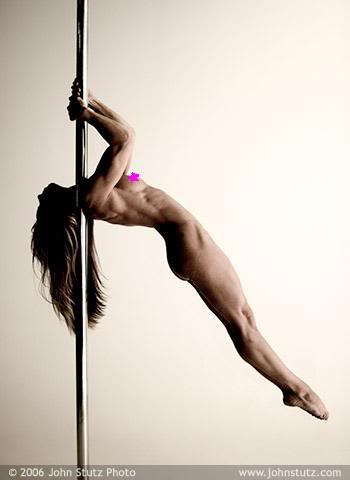 Make sure that you’re at least competent with this technique before you attempt this move.
Make sure that you’re at least competent with this technique before you attempt this move.
5. Dip Spin
The Dip Spin is simple to get started and to learn. It only requires an understanding of the Baseball Grip.
In the Dip Spin, you hold the pole with both arms. The heel of the inside foot is then raised. With the inside foot fixed firmly to the ground, you then execute a turn around the pole using the inside leg as an anchor point. The inside leg is dipped low, so the turning movement looks like a side lunge or single-leg squat.
The move stops when you complete a whole turn around the pole and the outside foot meets up with the static inside foot.
This move is great for beginning pole dancers to learn about momentum as well as how to control body movement as momentum changes through the move.
6. Fireman Spin
Similar to the Cradle Spin, learning the Fireman Spin is a great way to involve your entire body in the routine. You can use this technique to experiment and get used to the way your body moves when it’s close to the ground.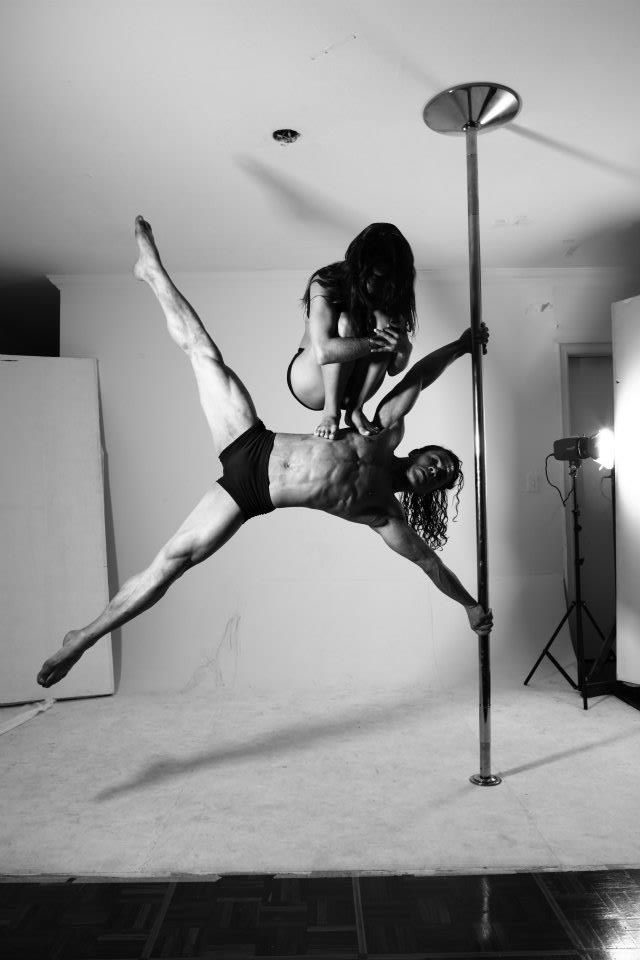
7. Wide Fireman Spin
An off-shoot of the Fireman Spin is the Wide Fireman Spin. In this modified move, you spread your knees farther apart while spinning on the pole. Besides giving the move a distinctly different look and style, your spinning rate is also going to be slower on the pole.
8. Knee Spin
In the Knee Spin, your body makes close contact with the pole. As such, it is a good move to experiment with when you’re first starting out. Experimenting with it will give you a better understanding of momentum and how to control it. Furthermore, the Knee Spin is a decent way to add variety and flair to your dance routine.
This dance move behaves differently depending on your pole. You can achieve a very high spin rate if you use a spin pole. If you use a static pole, this move is easy to control. With enough practice, it will become easy enough to enter that it feels instinctual and you can build up a lot of momentum and power.
9. Secretary Spin
This is one of the more attractive and sensual spin-type moves that you can learn as a beginner.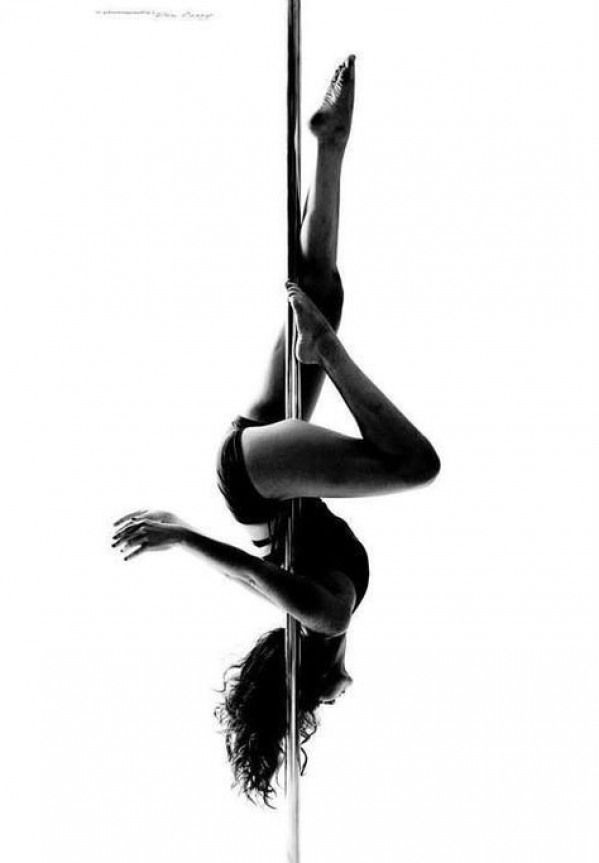 The Secretary Spin is a good way to get used to the feeling of having both of your feet off of the ground as you spin around the pole.
The Secretary Spin is a good way to get used to the feeling of having both of your feet off of the ground as you spin around the pole.
You can use this move to understand more about momentum, too. Enough pushing force on the outside leg and the closer your body is to the pole, the faster you’re going to spin. The movement naturally brings your body close to the pole, so the effect of the body’s proximity to the pose to the spinning rate is very noticeable.
10. Steparound Spin
If you’ve been paying close attention to each move thus far, you’ll notice that the Steparound Spin looks very similar to the Dip Spin. That’s true: the techniques are mostly the same between them. However, with the Steparound Spin, the inside leg isn’t lowered.
The Steparound Spin is a technically-easy move that any beginner can learn right away as it doesn’t require you to know any other technique. However, it’s not all fun and no usefulness. This spin can be incorporated into routines of any level and it can also be used to transition to other moves and spins.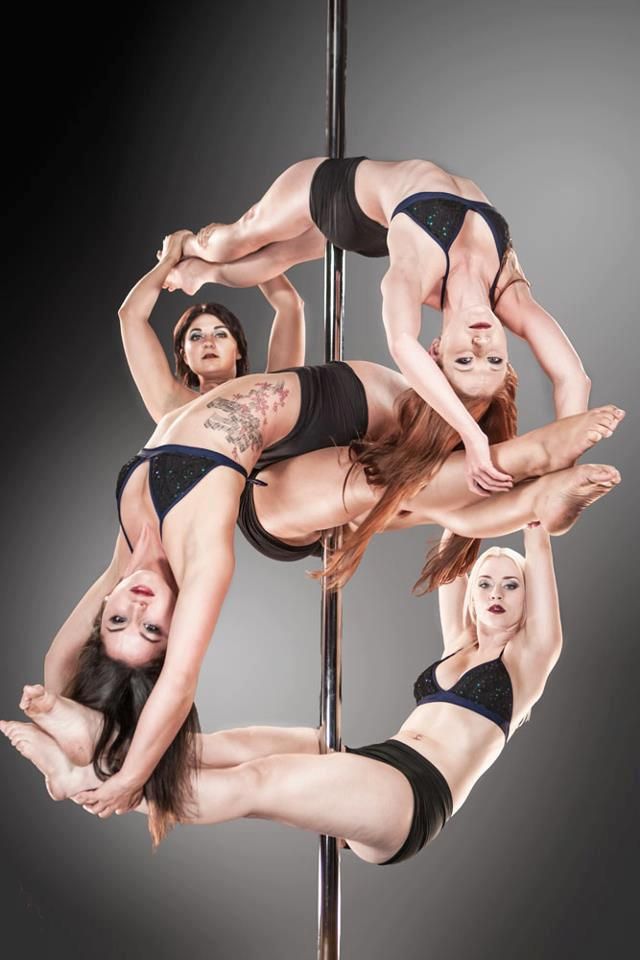
This move is best done on a static pole, but it’s also possible to do on a spin pole.
11. Basic Backbend (Pole Assisted)
Don’t underestimate the Basic Backbend just because it’s called “Basic”. It is among one of the most elegant and beautiful poses that you can make in pole dancing and can fit well in any dance routine. This ballet-like move can showcase your flexibility as well as your strength.
However, for beginners who are just trying this technique for the first time, it is important to be aware of the movement range and limitations of your back. Do not push your back beyond what it’s capable of, or you’ll end up with a back injury.
12. Basic Body Rolls
Incredibly sensual and versatile, the Basic Body Rolls can be added into any routine without much work. You can use this move as a “spacer” in-between different moments of a song. Alternatively, you can use it to highlight the sensuality of other dance moves.
The fluidity of the move means you can see for yourself what your body is capable of and the degree of its flexibility while practicing in front of a mirror.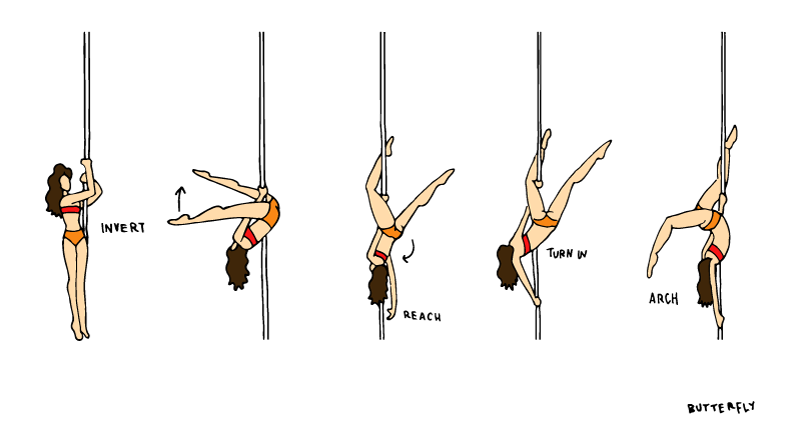 This knowledge is incredibly useful as it tells you how you can improve further.
This knowledge is incredibly useful as it tells you how you can improve further.
Most important thing when you’re practicing the Basic Body Rolls is to loosen up. The more rigid you are, the choppier the rolling movement is going to be. Since this technique is all about fluidity and laxness, that won’t do.
13. Basic Leg Waves
Also known as Bicycles, the Basic Leg Waves is floorwork (doesn’t involve an actual pole). When done well, the technique can do an excellent job at showcasing your gracefulness. It can be integrated into any floorwork routine.
What you need to remember when you perform this trick is to relax your body. Not a lot of fluidity is required (though it does help make the waving motion smoother and more attractive).
Depending on your dancing style, you can make the waving motion wide or narrow, eye-drawing or simple.
14. Basic Pole Climb
If you know the Basic Pole Climb, climbing up the pole is going to be less exhausting.
This technique allows you to ascend on the pole without having to use your muscle or put a lot of energy into the motion.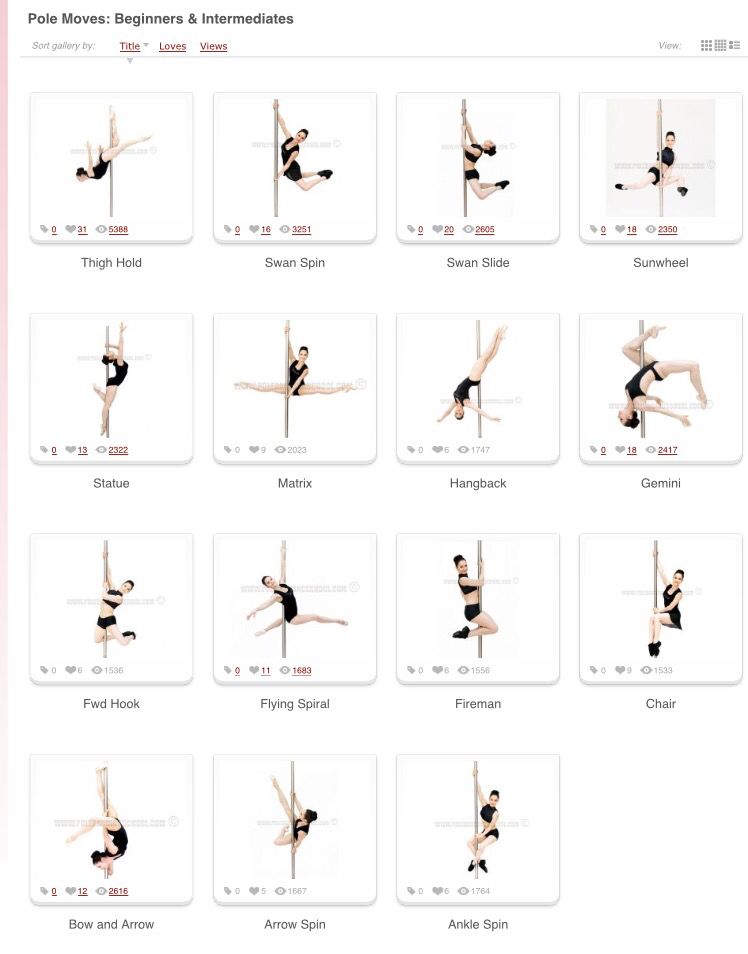 Specifically, you only need to apply strength to hold onto the pole and lift your legs off the ground. The upward motion is done by locking your hips and using them as leverage to climb.
Specifically, you only need to apply strength to hold onto the pole and lift your legs off the ground. The upward motion is done by locking your hips and using them as leverage to climb.
Though it may look simple, this is actually a pretty complicated move. So, you should only attempt it after you’re used to all the previous techniques as well as knowing how to grip the pole properly.
Using the Basic Pole Climb in your practice can help you understand how your body and the pole interact with one another.
15. Cleopatra
Source: Polepedia.comThe Cleopatra move is a floorwork trick that involves transitioning your legs from one side of the pole to the other. It’s relatively simple to do and doesn’t require a great deal of flexibility or technical know-how.
If you have a professional instructor, they will teach you to hold onto the pole at first. However, this is not necessary. The trick can be done without gripping the pole (or without using a pole at all).
16.
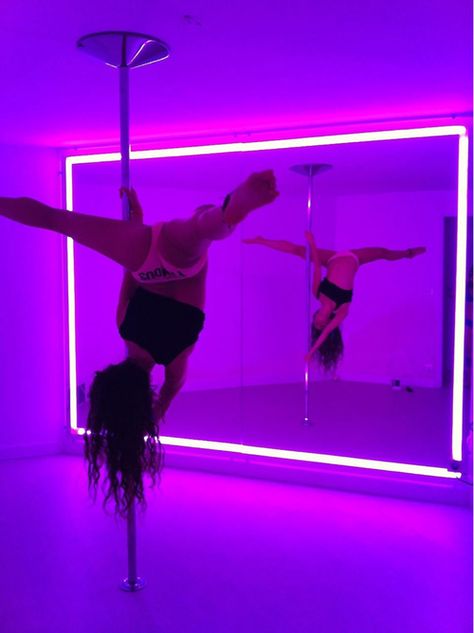 Drama Queen
Drama QueenThis is one of the more sophisticated beginner pole dance positions that you can do when you just first started out. The Drama Queen will allow your body to move around the pole more than most moves.
First, you should execute a pole sit, then bring your arm around the pole and connect the back of your arm with your torso. This locking movement will stabilize your body on the pole. Lastly, you will cocoon yourself around your interlocking legs at the front.
In this move, the more skin contact there is between yourself and the pole, the better. If there isn’t enough, there’s a decent chance that you could fall or slide off the pole. Furthermore, one hand should always be on the pole at all time. That will prevent you from falling backward.
17. Fan Kick
The Fan Kick can put your entire body into motion. Your hands are used to keep a strong grip on the pole. Then, your core and pelvis are used to sweep and swivel your legs widely. Lastly, your legs have to maintain a degree of fluidity and gracefulness as they sweep in the air.
This move can be used for a number of purposes. Adding it into a routine can improve the flair and beauty. You can use it to move around the pole mid-dance. Or, when you’re at a more advanced level, the Fan Kick can be used to transition to other difficult moves.
18. High Kick Hold
Similar to the Fan Kick, the High Kick Hold is a great way to add a highlight to your dance routine. Alternatively, it can be used to transition to other spin-type moves or to act as a marker for a downbeat in the song before you slide down the pole.
19. Hip Dips
Though it looks incredibly simple, the Hip Dips is an effective way to add a touch of sexiness to your performance. The move is often done behind the pole to highlight the neck, hips, and legs of the dancer. Highly effective at emphasizing a beat in a song.
However, it looks simple doesn’t mean it’s easy. The Hip Dips requires a decent amount of fluidity in the movement. It takes some practice to do the swaying motion without looking choppy or awkward.
20. Pirouette
The Pirouette is a transitional movement. Dancers typically incorporate it as a spacer between different pole tricks or to get into a starting position for squatting or exotic dance moves.
This simple Pirouette movement is the basic one. As your skill level goes up, you’ll get the opportunity to learn some more complicated variants of this move.
21. Pole Sit
The Pole Sit can be a good trick as well as a good exercise to get used to the feeling of having both legs off the ground. As there’s a lot of skin contact involved, you can use the Pole Sit in your practice session to learn more about skin contact and how it affects your posture, too.
This is a move that you need to master in order to nail other tricks, like the Drama Queen or the Tabletop. So, make sure to practice it often!
22. Secretary Sit
This is a variation of the Secretary Spin (but without the spinning). It’s a great way to get used to doing tricks that only involve one side of the body as well as practicing your sitting moves.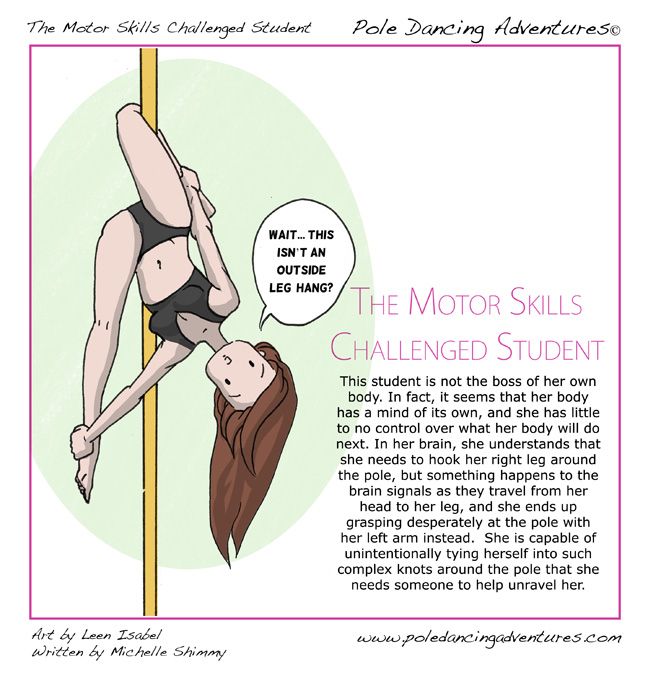
This is one of the moves that make use of your knee pits, so if you still feel a bit awkward using them, the Secretary Sit can be a good opportunity to learn.
Due to the natural beauty of the pose, it’s perfect for photoshoots.
23. Shoulder Stand
The Shoulder Stand can be leveraged to move around the pole as well as give your performance a bit more exotic. It can be done either barefoot or in high heels.
This move is supported by the pole, so you don’t need a lot of work to maintain balance. You also don’t need to be very flexible to pull this move successfully (but the more flexibly you are, the better the move will look.) So, this technique is great for beginners!
24. Sunwheel
In the Sunwheel, both hands will grip the pole. Step forward and push with your inside leg to get some velocity in. Swing your outside leg to gain more momentum. This momentum will carry you around the pole.
As you rotate, your hands should still grip the pole and your legs should be entirely off the ground.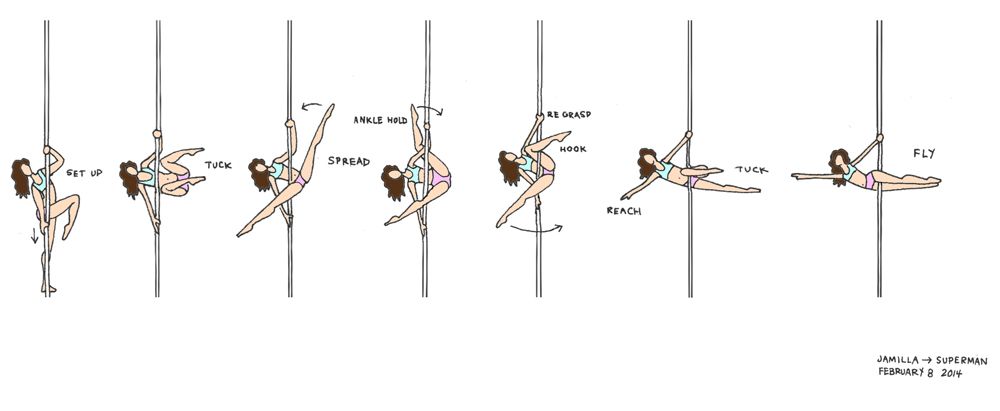
The Sunwheel can be a pretty trick to pull as it requires some flexibility in the hip. Some people may find it difficult to retract their legs up and above the ground.
25. Reverse Sunwheel
The Reverse Sunwheel is exactly like the Sunwheel … but backward. It’s the same situation as the Front Hook Spin versus the Back Hook Spin. Though the technique is pretty much the same, the different direction means the Reverse Sunwheel is mechanically different.
You can use this move to practice the sensation of spinning backward on the pole, which can feel quite strange if you don’t have a lot of practice.
Tips When Pole Dancing
Take Care Of The Pole
A clean pole is the easiest pole to perform or practice on. Before and after every session, wipe down the pole with a clean cloth or tissue paper to take off any sweat or skin oil that got onto it. When accumulated, they can make the pole dirty and slippery.
Do Not Use Skin Lotion
Skin lotion can reduce chafing and discomfort, but it will also make you more slippery and affect your overall performance.
Wear Shorts and Tank Top When You Practice
Skin contact with the pole is absolutely important in many maneuvers as it can decide the strength of your grip and overall security. Wearing shorts and tank tops during practice bare the maximum amount of skin, unlike legging or sleeved shirts.
Dance Barefoot Whenever Possible
Socks are slippery and shoes are grippy and cumbersome. Dance barefoot whenever possible. If you would like to wear heels during your performance (many dancers do), practice with them to get used to their bulk and weight.
Practice!
The more you practice, the easier it gets. Don’t get discouraged if you’re unable to pull a new trick or can’t get a grip style right. Keep on practicing and keep a positive, motivated mindset. You’ll get there!
Be Brave
The sensation of being off the ground, the fear of falling, and the strange sense of momentum can be anxiety-inducing. Many moves will require you to be brave and put faith in your body.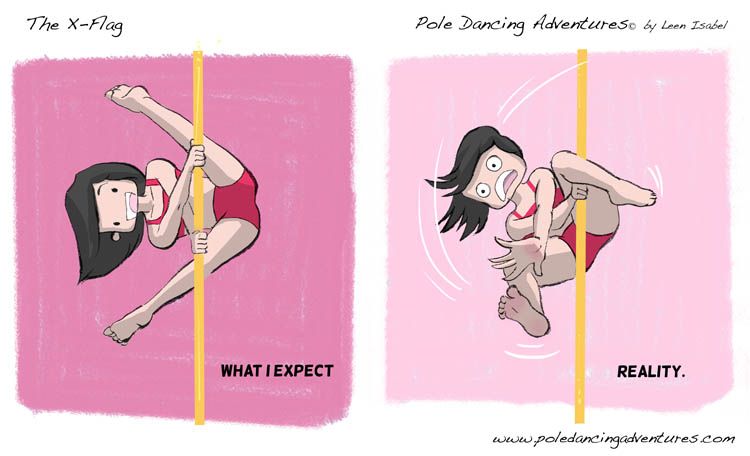
This is why it’s important to practice as much as possible. The more you practice, the more confident you will be.
Don’t Forget to Have Fun
Pole dancing isn’t just an exercise or a career, it’s also a fun hobby to get into. So, no matter what you do, don’t forget to have fun while performing or practicing. That’s the true value of pole dancing!
Final Words
Pole dancing is a diverse and complex sport. Though this list contains a lot of pole dance moves, it’s not all-inclusive. There are many more tricks and moves to learn. Of course, as your skill level goes up, you’re afforded certain “artistic liberties” and you can invent your own moves.
Good luck with your practice!
15 pole dance spins that will make you better at spinning • The Pole Dancer
by Miglena
Before you watch the video below, you might want to learn first why these 15 pole dance spins will make you a better pole dancer, or at least better at spinning.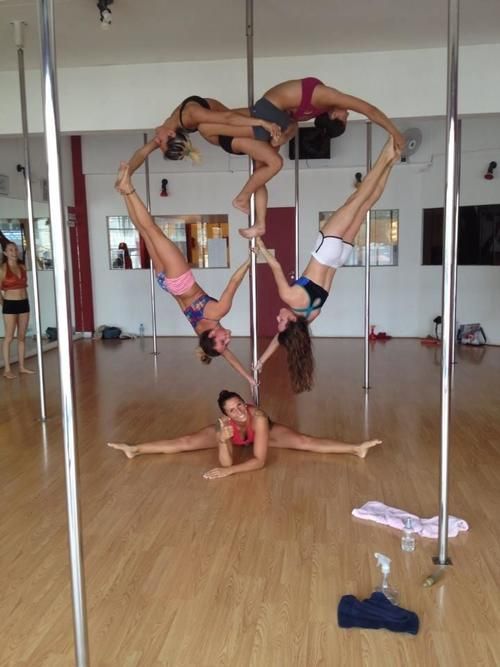
Video below ↓
1. YOU WANT TO CREATE SHAPES ON THE POLE
Spinning is perfect for exploring shapes and flowing between them. Since you are already spinning fluidly, transitions look much more fluid as well. Tiny changes to one move already appear as a different shape. With the 15 pole dance spins in this video you can start creating pretty and simple shapes low on the pole, before you move higher.
2. YOU’RE NOT STRONG ENOUGH TO HOLD TO THE SPINNING POLE
Holding to a spinning pole is usually a bit harder than holding to a static pole. Because of the centrifugal forces, your hands may start sliding quicker. Start building strength and conditioning for spinning with the beginner pole dance spins in this video and check out my video tutorials with additional progressions for each spin. But please keep in mind that some spins work best on static (one arm) and some work best on spinning (e.g. getting the hips around).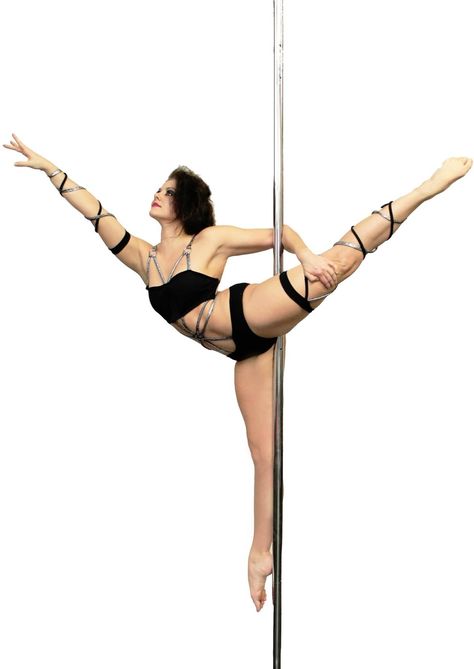
3. YOU GET DIZZY FROM SPINNING
Dizziness is normal and very common. The good news is – your body (and your nervous system) is able to adapt to the spinning movement. You can chew ginger, you can focus on a spot, but the most effective way is to practice spinning regularly. Use the beginner pole dance spins from this video to practice low on the pole. If you get dizzy, don’t worry – the static floor is just below you.
4. YOU’D LIKE TO TURN A TRICK INTO A COMBO WITH FLUID TRANSITIONS
You’ve learned a new trick and you’d like to turn it into a combo, but you always end up doing the same things? Instead of trying to come up with another spectacular trick in the air, think of how to start your dance, how to get in and out of the trick and how to give a little twist to simple moves. No matter if you are preparing a performance or training for yourself, your dance doesn’t start in the air. It starts before you get off the floor! Use the pole dance spins in this video as ideas for creating a seamless and fluid transition into your climbs and into your tricks.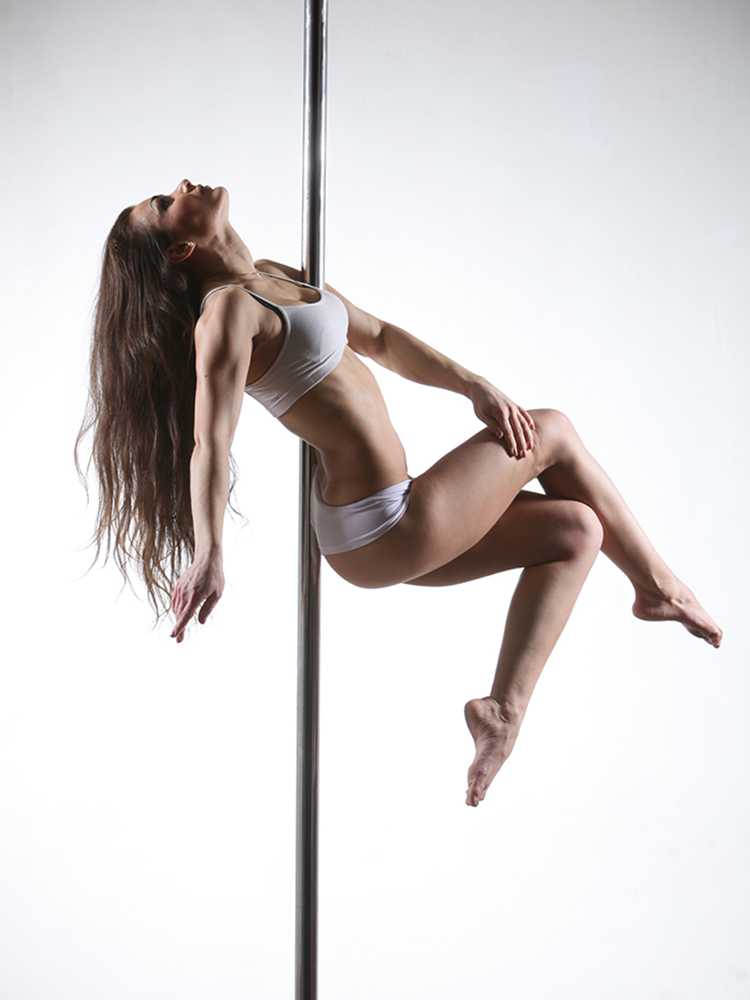
THE 15 SPINS INTO CLIMBING
When I planned and selected the spins for the series „15 spins into climbing“ I made sure to put my favourite spins into this compilation. But I also payed attention to cover progressively the essential spinning techniques in the single spin tutorials, that I’ll be releasing in the next weeks.
My idea for these series is to make it possible to learn from the very first beginners spin and to build your way up to the more advanced spins.
- Beginners spins 1-4 cover the basic hold grip.
- Spins 5-8 teach the forearm grip and the push-pull technique.
- Spins 9-11 teach how to use the natural momentum of the spin.
- Spins 12-15 are aerial and require advanced strength.
Some of the spins in this compilation are inspired by famous pole dancers and you’ll also find Marion Crampe’s signature spin into climb at the end of the video.
In the next days I’ll start releasing 1 MINUTE SHORT VIDEO TUTORIALS FOR EACH SPIN! So you can follow along, practice each one of them separately or simply check your technique with my tutorial.
To learn more, sign to my email list below and follow me on Instagram, Facebook and YouTube.
Learn the #1 Basic Hold Spin >
More from: 15 spins into climb, spinning
Ready to go from pole fitness to pole dancing?
Get my tips and tutorials for your graceful flow.
Pole Dance for Beginners
Pole dancing or Pole Dance, as they are also called, has recently gained extraordinary popularity. Many want to learn how to gracefully and easily perform difficult tricks, spin on a pole, and demonstrate the wonders of flexibility and plasticity.
This direction really has many advantages. Practicing regularly, a beginner dancer:
- develops muscles, improves figure;
- strengthens the respiratory and cardiovascular systems;
- improves immunity;
- learns to feel his body and control it;
- increases his self-esteem and feels even more attractive.
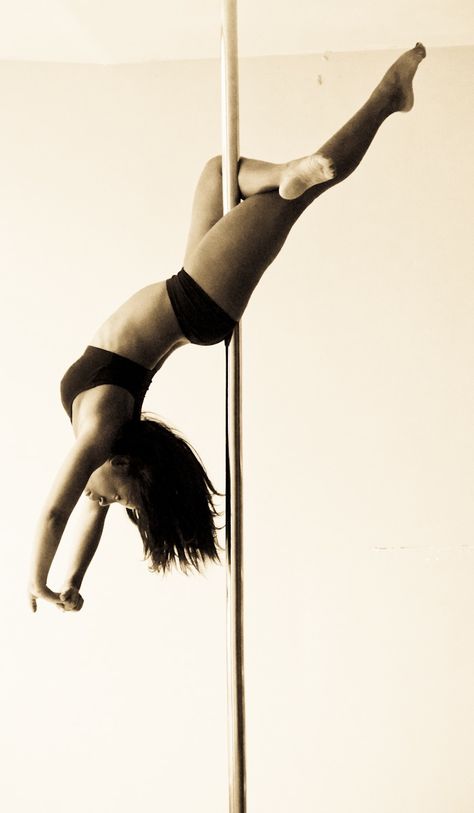
But of course it won't come all at once. You need to be ready for trials - both physical and moral. And to make it easier for you to deal with them, you began to enjoy training, check out a few tips. We hope you get something useful from them. By the way, in St. Petersburg, pole dancing is especially popular at Admiralteisky and Vyborgsky districts, including metro station Baltiyskaya and metro station Ozerki.
The right attitude is important
Many people give up after the first lesson on the pole. Faced with serious workloads, it can be hard to overpower yourself and continue. In addition, some compare themselves to other, more experienced athletes. And, of course, this comparison is often not in their favor. Remember: those who show the best result today conquer with their clever tricks, just like you, they started small . No one was born with such skills.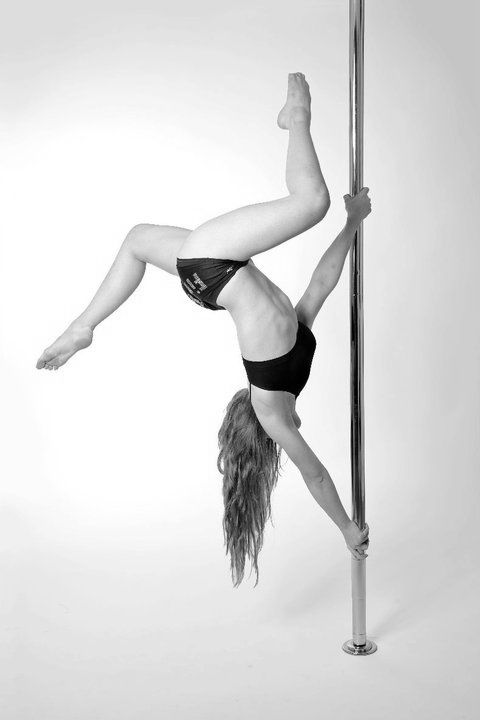 All this was achieved through hard training. Treat such people as great motivation. If they can do it, then you can too!
All this was achieved through hard training. Treat such people as great motivation. If they can do it, then you can too!
Pole dancing has been given observer status with the GAISF (General Association of International Sports Federations), due to which they can expect to be included in the Olympic program. In many ways, Katie Coates, an Englishwoman who founded the International Pole Sports Federation, contributed to this.
Get ready to work hard through physical pain at first. Bruises, abrasions, calluses, krepatura - all this should not come as a surprise to you. But, don't let such tests scare you. If you really want to succeed in this field, be patient . A nice "payment" for your efforts is just around the corner. The dancing beginner will soon begin to notice how the body rewards him for his hard work with growing strength, endurance and honing the curves of the physical form. When you begin to notice the first results, you will no longer be stopped, since you will not want to be limited by what you have already achieved.
Wear the right clothes
To get the most out of your pole training, it's important to wear the "right" clothes. For a warm-up, during which the muscles are prepared for further loads on the pole, you can wear leggings and a T-shirt. It is convenient to do strength and stretching exercises in them. For the pole, short, tight shorts, a tank top, or custom uniform are best. It must have the following properties:0005
- hygiene;
- breathability;
- excellent grip on the surface of the pole;
- thigh compression;
- good breast support;
- moisture absorption;
- hypoallergenic.
For the top, you can choose a T-shirt made in the “wrestler” style, which has a deep armhole in the area of the shoulder blades and enlarged cutouts under the arms (needed to grip the pylon). Also suitable is a top that has an elastic band in front under the chest, and a double placket in the back, formed in the form of the letter "X".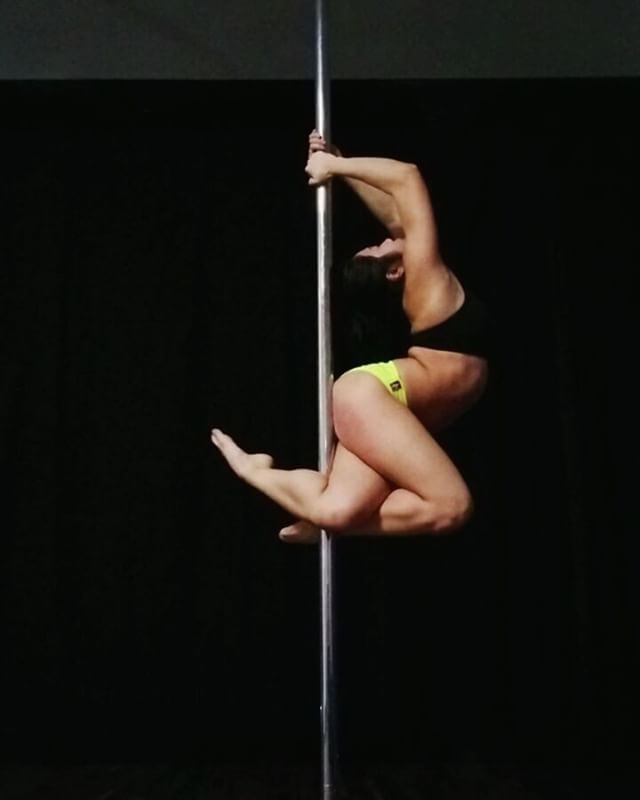 This style is also called "frog". Some people like the Carmen T-shirt with an asymmetrical strap thrown over one shoulder.
This style is also called "frog". Some people like the Carmen T-shirt with an asymmetrical strap thrown over one shoulder.
Gloves will not be superfluous either. They must be special, with an anti-slip coating. They usually have a lacquer base and lace, knitwear or microfiber inserts. So don't try to make them yourself. To reduce the risk of sprains and injuries, bandages are used - on the ankle, elbow, knee, wrist.
In the XII-XIII centuries in India, a very unusual direction of yoga on pillars called Mallakhamb was widespread. It shows an amazing similarity with modern pole dancing. This practice was intended primarily for men. Using poles, they performed complex tricks and thus trained their strength and endurance. Having achieved some success in this direction, they demonstrated their achievements to others.
As for shoes, you can train without them. It all depends on the individual preferences of the dancer. Some wear half-Czech shoes, while others, already relatively experienced, prefer strips - sandals on an extremely high platform and heels. By the way, they say that it is the strips that make it possible to achieve the maximum effect of the pole dance, seductiveness and elegance of movements.
By the way, they say that it is the strips that make it possible to achieve the maximum effect of the pole dance, seductiveness and elegance of movements.
Warm-up is essential
A good warm-up should never be neglected. Poorly warmed up muscles are easy to injure. Take 15 minutes for this important part of any workout. You can perform the following exercises on different parts of the body:
- Neck . Do tilts, turns, half-turns to the right and left, forward and backward 20 times, circular turns clockwise and counterclockwise 10 times.
- Chest muscles . Arch your back, round, spread your arms to the sides.
- Press . In addition to the standard twist on the press (you can do it with legs raised), do “scissors”, “bike”, swings for each leg for several approaches, as well as a plank on your hands.
- Buttocks and legs . Squats 30 times, lunges on each leg 20 times are the best option for warming up the muscles of the lower body.
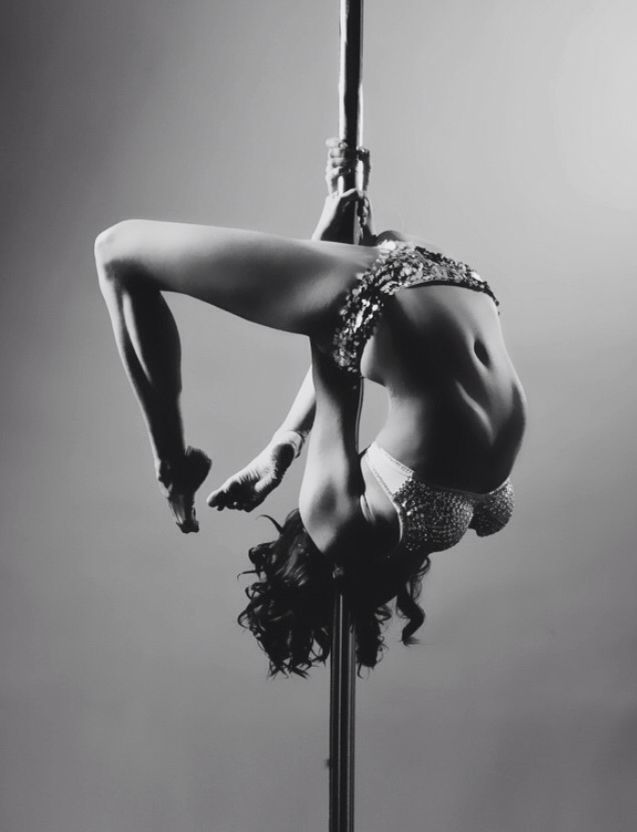
Pay special attention to the muscles of the arms , as they are the main load during the pole dance. Do push-ups regularly, try to pull yourself up on the horizontal bar, pump your arms with dumbbells and a barbell. However, a competent coach will always tell you what exercises you need to do and make sure that you do not start performing tricks on a pole without prior preparation.
Exercises for beginners
Tricks used in pole dancing can be divided into two main groups: static tricks (stationary) and twists (rotary movements around the pole). In turn, the tricks consist of " hangs " and " sits ", during which the dancer hangs or seems to "sit" on the pylon, respectively.
How to prepare for the effective performance of the static components of the dance? For a beginner, training of the following elements is suitable:
- " Chair ".
 It is necessary to clasp the pylon with your legs, firmly squeeze the inside of the thighs and hold on to the pole with your hands. In this case, the legs should be perpendicular to the pylon. If you still can't keep them straight, you can bend at the knees.
It is necessary to clasp the pylon with your legs, firmly squeeze the inside of the thighs and hold on to the pole with your hands. In this case, the legs should be perpendicular to the pylon. If you still can't keep them straight, you can bend at the knees. - " Fireman ". Cross your bent legs around the pole, hold with your hands and gracefully arch your back.
For a beginner, the following rotation exercises are also suitable:
- " Footboard ". It is necessary to straighten one arm, take it on the pylon above the head, and the other - at the level of the hips. Push off the floor with your feet and spin around the pole.
- " Frog ". Straighten your left arm and grasp the pole above your head. Bend the right one and grab the pylon at chest level. The left leg is wrapped around the pole. Push off with your right foot and spin.
The trainer will tell you how to do the exercises correctly and what needs to be corrected.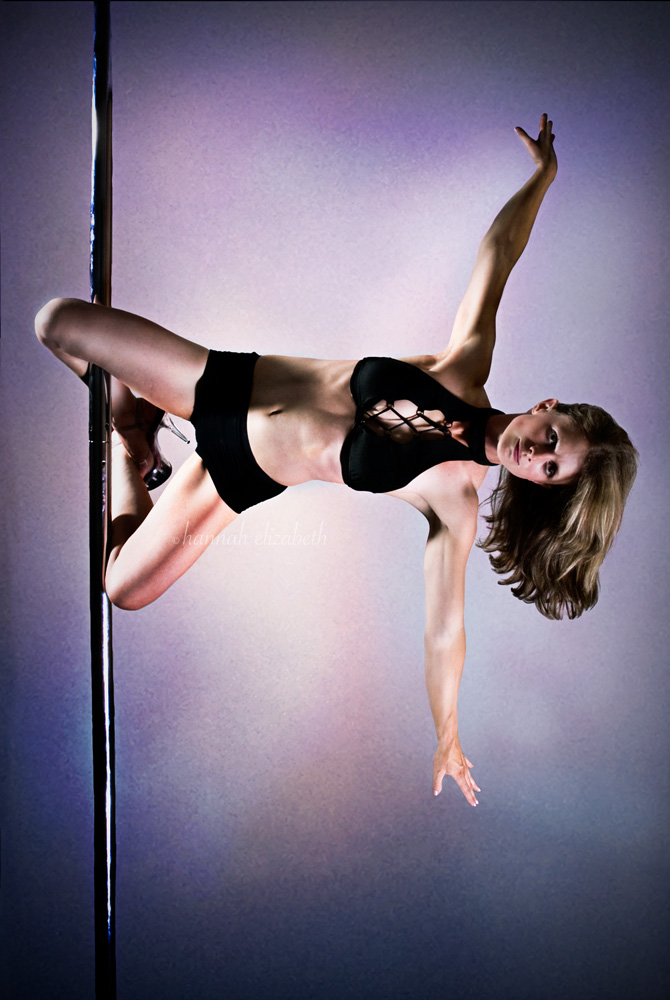 It is enough to practice 2-3 times a week (provided that you are not lazy) in order to see the first tangible results in a couple of months.
It is enough to practice 2-3 times a week (provided that you are not lazy) in order to see the first tangible results in a couple of months.
Does a beginner need to be physically fit?
Existing physical fitness is rather an advantage, but not a prerequisite for starting classes. Dance experience is not required at all. A lot of girls come to training with absolutely no base. All the necessary skills are acquired in the process, from lesson to lesson. The coach pays enough attention to gradual physical preparation, so no one will demand quick results from a beginner. And it's even better if you don't rush. The main thing is to do everything not for speed, but for quality.
You need to be prepared for the fact that few people succeed the first time. If something didn’t work out today, then a little more effort, and even difficult tricks will begin to succumb to you. After all, it is such a pleasure to reveal new, unknown boundaries of your body.
The use of article materials is allowed only if there is an active link to the source!!!
What do you need to know about Pole Dance tricks?
Pole Dance, or pole dancing, is a sports direction at the intersection of choreography and acrobatics.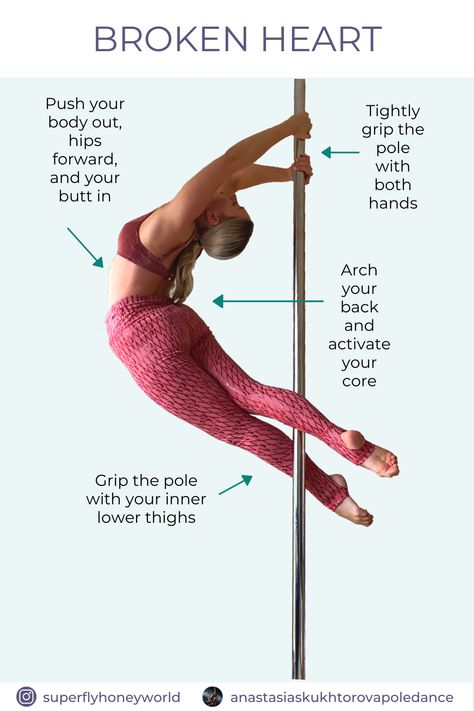 Dance moves are mixed with acrobatic tricks on a pole, which creates a really interesting effect. For the performer, this is an opportunity to prove himself in several styles at once, pump up muscles, develop endurance, flexibility, plasticity and not get bored in training, and for the audience - a bright and spectacular show that is interesting to watch. Given the almost complete absence of age restrictions and the variety of the program, it turns out to be an ideal direction for those who do not want to choose between dancing, stretching, tricks and power loads.
Dance moves are mixed with acrobatic tricks on a pole, which creates a really interesting effect. For the performer, this is an opportunity to prove himself in several styles at once, pump up muscles, develop endurance, flexibility, plasticity and not get bored in training, and for the audience - a bright and spectacular show that is interesting to watch. Given the almost complete absence of age restrictions and the variety of the program, it turns out to be an ideal direction for those who do not want to choose between dancing, stretching, tricks and power loads.
Trick component of pole dancing
Acrobatic elements are the basis of Pole Dance, which is present in any direction. If you remove the trick part, only dances will remain, and this is a completely different style.
Tricks performed in the air or from the floor, including a variety of twists, hangs, splits, flips, lifts with an emphasis on flexibility or strength. They are interconnected in successive bundles and combined with choreography at the pylon or in the stalls. Everything is performed to the music, without specific sequence requirements. This is the advantage of classes - there are no clear rules for connecting elements, and the links are built depending on the level and preferences of the dancer himself.
Everything is performed to the music, without specific sequence requirements. This is the advantage of classes - there are no clear rules for connecting elements, and the links are built depending on the level and preferences of the dancer himself.
Acrobatic elements are divided into several levels of difficulty (from beginners to professionals) and mastered gradually. More complex exercises are based on basic ones. Everything is worked out under the constant supervision of a coach, this helps to avoid injury.
Differences of tricks depending on the direction
Depending on the ratio of the choreographic and trick part, pole dance is divided into several directions:
- Exsotic Pole - about 70% to 30% in favor of dancing;
- Pole Art - balanced 50% to 50%;
- Pole Sport - 30% to 70% acrobatics.
The exotic dance is more about choreography, which is decorated with simple acrobatic elements on a pole. In terms of bales, this is the easiest direction, where it is enough to master only the base.